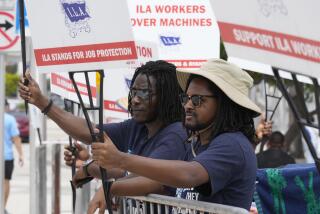Ports Post Record Volume but Avoid Big Traffic Jam
A crush of cargo destined for holiday shelves brought Southern California’s twin ports their busiest month ever in October without a hint of last year’s enormous floating traffic jam, which delayed merchandise and infuriated retailers.
Last month, the ports of Los Angeles and Long Beach handled a record 1.3 million twenty-foot-equivalent containers, a standard industry measurement for cargo boxes of varying size.
Nearly all other U.S. ports will handle less than that volume in an entire year.
With the holiday shipping rush almost over, a record 11.8 million shipping containers poured through the ports in the first 10 months of this year, up 9% from last year’s pace, which was also a record.
“We are still going strong,” said Bruce Seaton, acting executive director of the Los Angeles port, the nation’s largest.
And the increased traffic flowed smoothly, port officials said.
Almost every ship at the two ports docked on time and unloaded on schedule, a dramatic shift from last year when the ports were so swamped that more than 90 vessels were anchored offshore and forced to wait up to a week to unload.
An additional 200 ships were diverted to other harbors, and some customers permanently switched their business to other ports.
“The comfort level and the confidence level has begun to come back,” said Manny Aschemeyer, executive director of the Marine Exchange of Southern California, which tracks vessel movements at the ports of Los Angeles and Long Beach for clients around the world. “People are saying ‘Yes, we can ship our goods through Southern California and have them arrive on time.’ ”
The improvement is the result of an operational overhaul at the ports, which added thousands of dockworkers, opened cargo terminals on nights and weekends and adopted a “congestion fee” for shippers that move cargo during peak hours, said Anne Van Praagh, lead analyst of U.S. ports for Moody’s Investors Service in New York.
Because of the off-hours cargo program, the first by a major U.S. port, about a third of containers are picked up or dropped off at night or on weekends.
“We think they have done remarkably well,” Van Praagh said.
The two ports still have significant problems. Neighbors are outraged over the ports’ contribution to the country’s smoggiest air and most congested freeways, and the Los Angeles port has been without a permanent executive director for more than a year.
For those who use the ports, however, the changes have been welcome.
“We were in damage control mode last year and this year is much improved,” said Phillip T. Wright, West Coast vice president of Zim-American Israeli Shipping Co., which operates more than 80 vessels worldwide.
At Sears Holding Corp., “our goods are flowing better, with very little disruption from Los Angeles and Long Beach,” spokesman Chris Brathwaite said.
“It has been much easier this year. The nighttime operations have helped us in a big way,” said Jaime Martinez, West Coast distribution manager for Ikea North America. The company this month leased an additional 326,000 square feet of warehouse space at the Tejon Industrial Complex along Interstate 5 just north of the Grapevine to accommodate new business through the ports.
Charles Woo, chief executive of Megatoys Inc. of Los Angeles, had to hire additional workers and pay overtime last year because of delays and unpredictable delivery times from the ports.
This year, “it’s much more efficient,” Woo said.
The meltdown at the harbors last year “was a wake-up call for the ports and the people that are charged with making them function,” said John Husing, vice president of Economics and Politics Inc., a Redlands-based consulting firm.
“Now, they thoroughly understand that there is an economic asset here that can in fact be damaged and lost,” he said.
More to Read
Sign up for Essential California
The most important California stories and recommendations in your inbox every morning.
You may occasionally receive promotional content from the Los Angeles Times.











